County Extension Agent
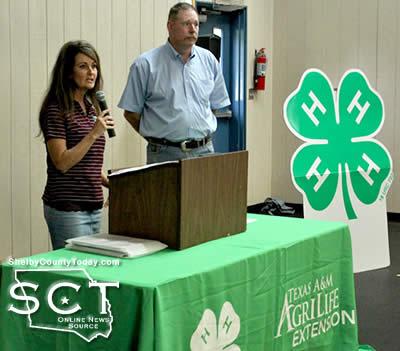
August 27, 2017 - (Album) - Despite pending rain a full house attended the Shelby County 4-H kickoff event held Sunday, August 27, 2017 in the gym next to their new facility located at 266 Nacogdoches Street in Center.
AgriLife Extension agents and team members welcomed all. Jheri-Lynn McSwain, County Extension Agent, Family Community Health Agent, "Welcome to Shelby County 4-H. I'm glad that you came out today in spite of [Tropical Storm] Harvey. And I'm glad Harvey hasn't produced as much rain as we anticipated, yet. So, thank you for coming out on this Sunday afternoon."
For those new to 4-H, McSwain addressed, "We're glad that you are here to explore the opportunity that 4-H can offer you." She spoke about what 4-H is about, "It is an organization that has been in existence for over 100 years, so it's well grounded." Texas has more than 550,000 youth who are involved in 4-H experiences. Projects include record book and leadership, food and nutrition, photography, textiles and fashion, robotics, taxidermy, shooting sports, archery, virtual fishing, livestock (beef, goats, rabbits, poultry), and horse project.
Megan Dunn, Shelby County 4-H president, introduced herself, "This year I was announced District 5 4-H President, elected, so now I'm on the Texas 4-H State Council and I'm really excited to be able to explore those adventures with the other state council members and come back to y'all and tell y'all the new experiences that we have to offer here in Shelby County. Our club is a little bit different this year; now we are countywide. And as y'all can see, y'all are all going to be together throughout the year. So, its going to be a lot of fun."
Dunn continued to explain that she is the Texas 4-H Livestock ambassador. She said as she mentioned different projects around the room, "The livestock project is my passion but that doesn't mean for y'all that it has to be yours. That's what I am here to promote as the Livestock Ambassador program, but I'm also here for the food, the fashion, and photography which is an awesome part of 4-H. Another thing is just get out there and try to find your passion, that's what I'm all about, is go out there and figure out which project is yours, go explore, try everything you can, and then we will go from there."
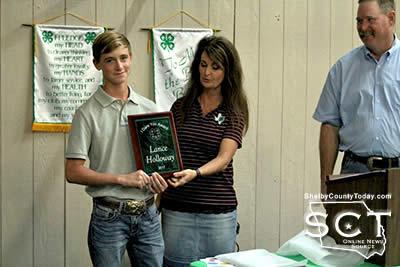
Lane Dunn, County Extension Agent for Agri Natural Resources then began presentation of awards. The 'I Dare You' Award was presented to Lance Holloway who started 4-H in the 3rd grade and is now in the 8th grade. He has competed in State indoor archery events and State outdoor archery games in San Antonio. He won People's Choice award as a junior contestant in photography at the East Texas Poultry Festival. He has competed many times in virtual fishing and has won three times in the countywide tournament. In 2016, Holloway competed in the Outdoor Challenge and he and his partner placed 1st in the state. In shotgun he has won numerous high point belt buckles in county shoots and the District 5 high overall three in the last five years and placed 2nd at the State Whiz-bang this year.
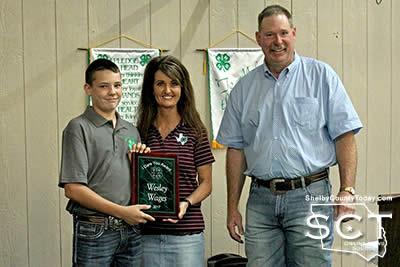
A second 'I Dare You' Award winner was Wesley Wages. He has been in 4-H since 8 years old and in the 3rd grade. He started off with goats and poultry projects along with many others. Wages passion is the Heifer project. Along with maintaining all of his livestock projects, he maintains good grades and is always willing to come out and serve including working with Ag Ed Day. Community service is important to him.
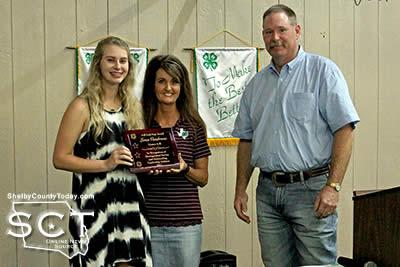
A Gold Star Award was presented to Lauren Vandrovec. She began in 4-H at the age of 5 as a clover coming to meetings along with her older brother. She started as a member of the Shelbyville 4-H and has been a member for more than 8 years. She is currently a junior at Shelbyville High School. Her first project was raising a pen of rabbits. The project nearest to her heart has always been the horse project and includes drill, barrels, poles, stakes, team penning, ranch sporting, trail and western riding. She has been successful in horse judging and quiz bowl. Vandrovec has also participated in poultry, food, fashion, and photography. She has held various club officer positions for her club.
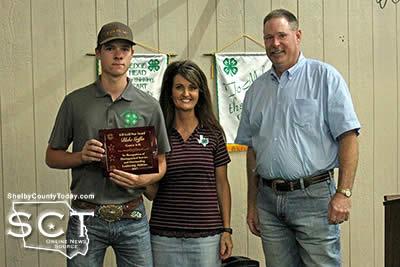
Another Gold Star Award was presented to Blake Griffin. He has been involved in 4-H for many years as well. He has been involved in poultry project, livestock project showing steers, shooting sports, and the horse project. His passion is also horses and has competed on the District and State level. He won Paul Harvey's Top Hand Award. This year in Abilene at the State Horse Show he placed 1st in cutting, 1st in breakaway roping, 2nd in team roping, and 2nd in tie down calf roping making him the high point roper at the State show.
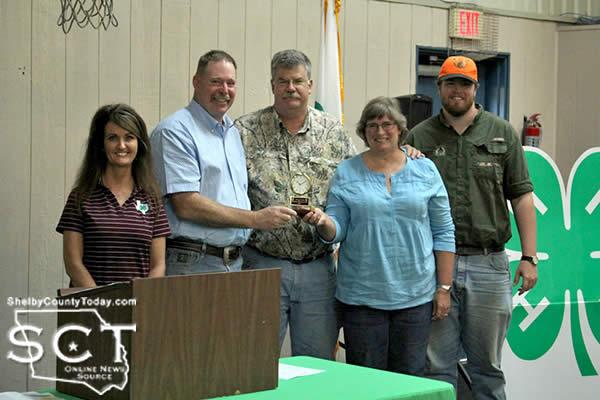
The 'Friend of 4-H' Award was presented to Hawkeye Hunting Club and its owners Mr. and Mrs. Mark Brueggeman and their son Kevin. Fairly new to Shelby County, they started off by helping the shooting sports project allowing 4-H to utilize their facility. They participated in the livestock show and sale.
Dunn said speaking about the Brueggemans, "[The kids] can't do this without people coming in and giving their support to go and then, that support allows these kiddos to go on and go to college and do some things that they have dreams on and I think [the Brueggemans] realize how important our youth are and we greatly appreciate that."
The Shelby County 4-H Club will meet the 1st Monday of each month at 6pm in the County Extension Office which is now located at 266 Nacogdoches Street in Center. The club will not meet on September 4th due to it being a holiday and will meet on September 11, 2017 at 6pm.
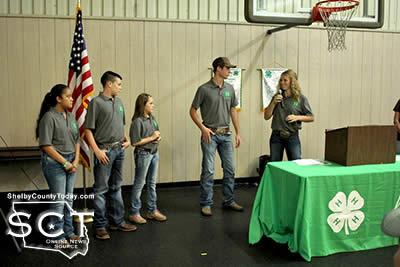
Upcoming events and project kick-off schedule:
- August 29 - Food at 5:30pm, Textiles at 6pm, Robotics at 6:30pm
- September 1 - Enrollment opens
- September 3 - Last day to order 'One Day 4-H' shirts
- September 11 - 4-H Club meeting at 6pm
- September 18 - Shooting sports and archery at 6pm
- September 23 - One Day 4-H at Historic Courthouse at 8am
- September 25 - Taxidermy at 6pm
The AgriLife team is Lane Dunn, County Extension Agent, Agri Natural Resources Agent; Jheri-Lynn McSwain, County Extension Agent, Family Community Health Agent; Feleshia Thompson, Better Living for Texans Extension Assistant; and Daphne Lovell staff secretary. Dunn said, "Please don't hesitate to contact us as you may have some questions over today or any other things."
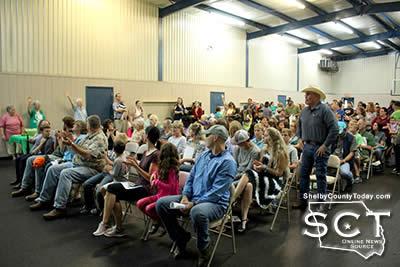
Links:
- Like us on Facebook: https://www.facebook.com/shelbycountytexasextension
- To sign up: https://www.4honline.com/ (Open enrollment starts September 1st)
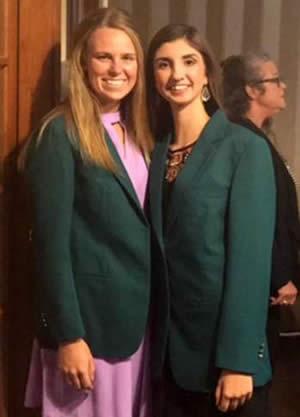 August 4, 2017 - Texas A&M AgriLife Extension Service is comprised of 12 districts covering all 254 counties in Texas, and Shelby County is part of District 5 which is composed of 22 counties in the East region. Recently, the district conducted a leadership camp in Laneville for youth in grades 9 to 12. At the camp, participants learned the importance of being a leader for their community, what makes a good public speaker, and giving back to their counties through community service opportunities. At the conclusion of the camp, these youth leaders were given the chance to present a speech on the importance leadership within their counties and participate in a peer-led interview.
August 4, 2017 - Texas A&M AgriLife Extension Service is comprised of 12 districts covering all 254 counties in Texas, and Shelby County is part of District 5 which is composed of 22 counties in the East region. Recently, the district conducted a leadership camp in Laneville for youth in grades 9 to 12. At the camp, participants learned the importance of being a leader for their community, what makes a good public speaker, and giving back to their counties through community service opportunities. At the conclusion of the camp, these youth leaders were given the chance to present a speech on the importance leadership within their counties and participate in a peer-led interview.
Megan Dunn, a Shelby County 4-H member participated in this opportunity and because of her motivating speech and outstanding interview, she was selected to represent the district as president. In addition, Megan also selected for a position on the state 4-H council.
The Texas 4-H Council is a team of 4-H members elected by their peers from across the state of Texas representing the twelve AgriLife Extension districts. Serving as ambassadors for the Texas 4-H program, members represent the organization statewide while collaborating with Extension faculty to plan, coordinate, and facilitate activities and events.
Megan also serves the state as a Texas 4-H Livestock Ambassador. As a livestock ambassador, she is provided additional opportunities to develop and practice advanced leadership skills related to mentoring other youth and to advocate for animal agriculture. We would like to wish congratulations to Megan for selection to these top district and state positions.
If you have any questions regarding 4-H, please do not hesitate to contact the Shelby County Extension Office at 936-598-7744, Lane Dunn, Ag/NR Agent and Jheri-Lynn McSwain, FCS Agent. Be sure to check us out on Facebook at Shelby Extension.
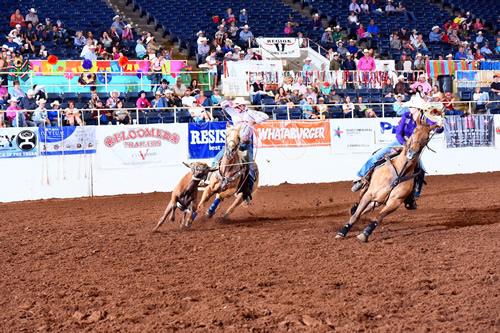
August 2, 2017 - Shelby County 4-H member, Blake Griffin wins big at the State 4-H horse show. The show was held in Abilene the last week of July. Blake places first in cutting, first in breakaway roping, second in team roping and second in tie down calf roping.
 Blake won the high point roper saddle for his efforts. As a result of these outstanding placings, Blake also won four belt buckles, a pair of Anderson Bean boots, and a head stall for his horse. The high point roping saddle has also been won by former Shelby County 4 H members Dakota Klein in 2000 and Blake’s uncle David Griffin in 1982.
Blake won the high point roper saddle for his efforts. As a result of these outstanding placings, Blake also won four belt buckles, a pair of Anderson Bean boots, and a head stall for his horse. The high point roping saddle has also been won by former Shelby County 4 H members Dakota Klein in 2000 and Blake’s uncle David Griffin in 1982.
In addition to his accomplishments at State, he also placed well at the District Horse Show winning two belt buckles for Senior tie down and team roper. Please help us congratulate Blake on a job well done.
If you would like to participate in this project or any other 4-H project in Shelby County, contact Lane Dunn, County Extension Agent – Ag/NR at 936-598-7744 or email at jldunn@ag.tamu.edu.
The members of Texas A&M AgriLife will provide equal opportunities in programs and activities, education, and employment to all persons regardless of race, color, sex, religion, national origin, age, disability, genetic information, veteran status, sexual orientation or gender identity and will strive to achieve full and equal employment opportunity throughout Texas A&M AgriLife. The Texas A&M University System, U.S. Department of Agriculture, and the County Commissioners Courts of Texas Cooperating. Anyone needing special assistance at an Extension Program should contact the Texas A&M AgriLife Extension office of Shelby County at (936) 598-7744 at least two weeks prior to the program or event.
Submitted by Lane Dunn
July 7, 2017 - (Flyer) - Texas A&M AgriLife Extension Shelby County will be hosting a canning workshop on Saturday, July 15, 2017 from 1pm to 4pm at the Extension office, 266 Nacogdoches Street, Center, TX 75935.
The focus of this fun, interactive workshop will be on making and canning tasty pickles, jam and salsa safely. An abundance of home grown fruits and vegetables often triggers the desire to can foods at home. While this can be a fun and rewarding way to keep foods long after the season ends, care must be taken to assure that foods canned at home are safe to eat. Attend this fun and informative food preservation workshop if you would like to learn hands-on how to make and preserve fruit and vegetables. The 6th edition of So Easy to Preserve by Cooperative Extension Service of The University of Georgia will be available for purchase at a discount of $15 per book.
Registration and payment in advance is required and due by July 12th. The cost for this workshop is $20 per person. Each participant will take home a jar of salsa, pickles and jam. A special thank you to Shelby County Farm Bureau for sponsoring this program. If you would like to register, please contact Daphne at 936-598-7744. For more information, contact Jheri-Lynn McSwain, CEA-FCS at 936-598-7744.
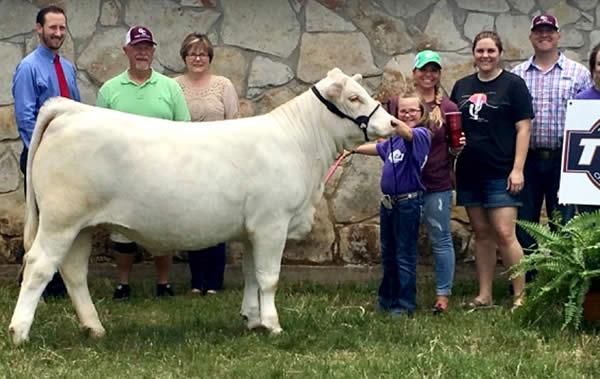
June 28, 2017 - We would like to say congratulations on a job well done to Ms. Camille Greer of Shelby County 4-H and Greer Charolais. Camille Greer showed her May 2016 heifer at the Texas Junior Charolais Show June 11 in Salado. The heifer was chosen by Judge Joe Rathman as Reserve Champion heifer of the show. She also placed second with her cow/calf pair. Both females were bred by Greer Charolais.
Great day at the Charolais Junior National for Camille Greer and Greer Charolais. Class winner with the pair, GC Miss Roxy Firewater 511 P and bull calf, GC Mount Rushmore 707 P. Fourth with GC Miss Kingsbury Sophie 608 P. All bred by Greer Charolais. Thanks to all the great people of Nebraska for a phenomenal Junior National!

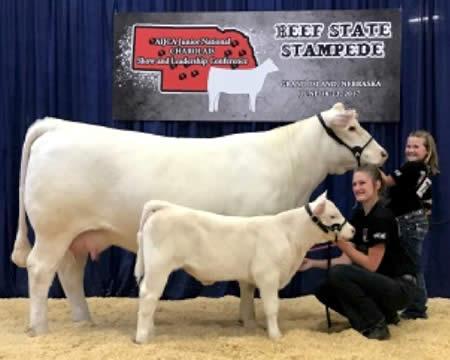
Learn, Grow, Eat and Go!
June 23, 2017 - School gardens have arrived as a “must have” popular project to encourage student interest in science and nutrition. The Learn, Grow, Eat & GO! (LGEG) Program has multiple components including a garden, classroom curriculum, vegetable tasting & recipe demonstrations, student journal, books, family stories and Walk Across Texas! The LGEG classroom curriculum is designed for 3-5th grades with a focus on science, math, language arts and health. The WAT! Program is appropriate for all grades and has supporting activities for a variety of subject maters. The hands-on learning within the program has been shown to engage all students! These components can foster connections across the campus, district and within the community. Schools, students and families get the most benefit when LGEG and all components are fully implemented!
On Wednesday, July 19, 2017, Texas A&M AgriLife Extension Service will host a Learn, Grow, Eat & Go! hands on workshop and training for schools, youth development organizations, community partners and county agents from across the state. We will walk through the lessons, plant a container garden, taste vegetables and participate in food demonstrations.
This training will be located at the Nacogdoches County Extension office located on 203 West Main Street in Nacogdoches Texas. With the support of gracious donors from Nacogdoches County, LGEG Curriculum materials will be available for a reduced price at the training.
The training will be from 9:00 am – 4:00 pm with a fee of $25 to cover lunch and supplies. If you have any questions Jheri-Lynn McSwain, Shelby CEA-FCS or 936-598-7744 or jlmcswain@ag.tamu.edu. CBEC Hours will be given and Certificates will also be available. Make checks payable to Shelby FCS Account and mail to: Nacogdoches County Extension Office, c\o LGEG, 203 W. Main Street, Nacogdoches, TX 77843.
Submitted by Deborah Sanford
May 23, 2017 - (Flyer) - Diabetes is a growing issue in American that is affecting more and more people every day. Living as a diabetic can be challenging and confusing. Trying to figure out what you can and cannot eat can present a challenge when you are not sure of the true facts regarding diabetes. To help educate the Shelby County community this topic, Texas A&M AgriLife Extension Service in conjunction with sponsor Nacogdoches Medical Center will present Cooking Well with Diabetes classes.
This will be a two-lesson series class presented July 22 and 29, 2017 at the Shelby County Extension office at their new location of 266 Nacogdoches Street in Center, Texas. The classes start at 9:30am and will conclude with lunch at 12:30pm. The cost of the classes is a one-time registration fee of $20. Topics will include recognizing carbohydrates in recipes and using sweeteners effectively, making recipes with fat better, reducing sodium and increasing fiber, and special event recipes that are healthy and delicious. These interactive classes will include research based information, delicious diabetes friendly recipes demonstrations and tastings, lunch, and drawings for various door prizes.
For more information or to register for the classes, contact the Shelby County Extension office at 936-598-7744 or email Jheri-Lynn McSwain, CEA-FCS at jlmcswain@ag.tamu.edu. Registration in advance is required to participate in these informative classes.
June 2, 2017 - Unfortunately, seat belts do not come in one-size-fits-all. In fact, the seat belt that is designed to save an adult’s life in a crash does not fit a young child. And, the poor fit of the seat belt can actually cause serious injuries or even death during a crash. Many parents are under the impression that a child can be moved to the vehicle seat belt system when they have outgrown the weight limits of their child safety seat. Most conventional forward-facing child safety seats have a 5-point harness system that can be used until at least 40 pounds. However, most children weigh 40 pounds long before they are tall enough to fit in the vehicle lap/shoulder belt.
Children do not fit well in the vehicle lap/shoulder belts that were designed for adults who are at least 4 feet 9 inches tall. Instead of fitting properly over the lower hips, the lap belt rides over the soft tissues of the abdomen and can cause severe injury or death. The shoulder portion of the belt hits the child’s neck or face instead of lying flat across the chest. This causes many children to place the shoulder belt behind their back, leaving them with no upper body protection. A booster seat ‘boosts’ the child up so the lap/shoulder belt will fit correctly and provide protection in a crash.
Texas A&M AgriLife Extension Agent, Jheri-Lynn McSwain, Shelby County, reminds parents that correctly using a booster seat can protect a child from being thrown around the vehicle or being totally ejected in a crash. In a crash, children who are incorrectly restrained by a lap/shoulder belt are likely to sustain serious injuries to internal organs, as well as the head and spinal cord. In fact, these abdominal and spinal injuries are medically referred to as “Seat Belt Syndrome.”
Motor vehicle crashes continue to be one of the leading causes of death and injury for children 14 and under. Car seats, including boosters, have been proven to be effective in preventing injuries and deaths and studies show that booster seats can reduce the risk of injury by 59 percent. But children in this age group are the least likely to be properly restrained. Surveys conducted during 2016 by the Texas A&M Transportation Institute found that only 31.8% of 5-9 year olds in Texas were correctly restrained. In Texas, fatalities in the 5-9 year old age group are nearly twice as high as the national rate.
The law in Texas requires children under 8 years old, unless taller than 4 feet 9 inches, to be in a child restraint system according to the manufacturer’s instructions. According to the law, an 8 year old can legally ride in the seat belt, but only a small percentage of 8 year olds are 4 feet 9 inches tall. While not every child who is 4 feet 9 inches will fit the seat belt — due to some children being longer in the torso and some children having longer legs — the average child reaches 4 feet 9 inches at age 11! Best practice is to keep the child in a booster seat until the lap/shoulder belts fits, which is usually sometime between ages 8-12.
The injury rate and high costs associated with medical care and lost productivity for families is huge. Booster seats are an affordable solution for protecting children in the 4 to 8-plus age group. The cost of booster seats is low; generally between $15 to $40 for a basic booster seat. Researchers estimate that a $30 booster seat generates nearly $2,000 in benefit to society from reduced health-care expenses. Booster seats offer a low-cost solution to a high-cost problem.
When is your child ready for the seat belt?
Take the Five Step Test
Does the child sit all the way back against the auto seat?
Do the child’s knees bend comfortably at the edge of the vehicle?
Does the belt cross the shoulder between the neck and arm?
Is the lap belt as low as possible, touching the thighs?
Can the child stay seated like this for the whole trip?
If you answered ‘no’ to any of these questions, your child needs a booster seat to make both the shoulder belt and the lap belt fit right for the best crash protection. Your child will be more comfortable, too!
Appointments for booster seat fittings are available each Friday, beginning June 2, 2017, through the Shelby County Extension office. Call Daphne Lovell at 936-598-7744 to schedule your appointment for a free child safety seat inspection, or visit http://buckleup.tamu.edu to find a certified child passenger safety technician in your area.
Source: SafetyBeltSafe U.S.A. (www.carseat.org)

Pictured left to right: Logan Holloway, Lance Holloway, Dawson McFaddin, Colton Gutermuth, Nic Lambert, Konner Windham, and Colby Lout
May 24, 2017 - It was several great weekends for the Shelby County 4h Shooters. On April 23rd, 2017, the Madison County Whizbang was held in Madisonville, TX and representing Shelby County 4H shooters were Lance Holloway, Logan Holloway, Nic Lambert, Dawson McFaddin, and Konner Windham.
The results were as follows:
Senior I
Lance Holloway (shooting up) - 4th in Trap
Logan Holloway - 3rd in Trap, 2nd in Skeet, 4th in Whizbang and Reserve HOA (High Over All)
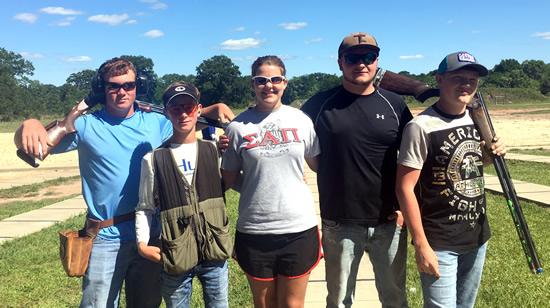
Pictured Left to Right: Logan Holloway, Lance Holloway, Konner Windham, Nic Lambert, and Dawson McFaddin
Colton Gutermuth, Colby Lout, and Dawson McFaddin had another great shooting weekend, May 6th at Walker County Whizbang in Crockett, TX.
Results were as follows:
Junior Division
Colby Lout - 2nd place Trap, 3rd place Whizbang
Senior I Division
Colton Gutermuth - 2nd in Whizbang
Dawson McFaddin - 3rd in Skeet

Pictured Left to Right: Colby Lout, Colton Gutermuth, and Dawson McFaddin
Jefferson County Whizbang was held in Winnie, TX on May 7th. Shelby County 4H shooter Colton Gutermuth represented Shelby County very well by placing 2nd in Trap and 3rd in Skeet. Congratulations to Colton!
 The 2017 District 5 4-H Shoot was held at Pines Gun Club in Lufkin, TX on May 13th. District 5 consists of 22 counties in East Texas. Representing Shelby County 4-H Shooters were: Colton Gutermuth, Lance Holloway, Nic Lambert, Colby Lout, Dawson McFaddin and Konner Windham.
The 2017 District 5 4-H Shoot was held at Pines Gun Club in Lufkin, TX on May 13th. District 5 consists of 22 counties in East Texas. Representing Shelby County 4-H Shooters were: Colton Gutermuth, Lance Holloway, Nic Lambert, Colby Lout, Dawson McFaddin and Konner Windham.
Results were as follows:
Junior Division
Colby Lout - 2nd in Sporting Clays, 2nd in 5 Stand, 1st in Skeet, 2nd in Trap, and 1st in Tower
Intermediate Division
Lance Holloway - 2nd in Sporting Clays, 1st in 5 Stand, 1st in Skeet, 1st in Trap, 3rd in Tower and Intermediate High Over All (HOA)
Senior I Division
Dawson McFaddin - 2nd in Sporting Clays, 4th in Tower
Colton Gutermuth - 5th in Sporting Clays, 3rd in Skeet, 5th in Trap, 2nd in Tower
Logan Holloway - 1st in Sporting Clays, 1st in 5 Stand, 2nd in Skeet, 2nd in Trap, 5th in Tower and Senior 1 HOA
Senior II Division
Nicholas Lambert - 1st in Sporting Clays, 1st in 5 Stand, 2nd in Skeet and 4th in Tower
Konner Windham - 3rd in Sporting Clays, 5th in 5 Stand, 4th in Skeet, 5th in Trap, and 1st in Tower and Overall HOA Ladies
If you have any questions or would like more information regarding 4-H, please give us a call at 936-598-7744.
People need to be extra cautious when outdoors, with more of the critters after a mild winter
 May 23, 2017 (HealthDay News) - Scientists have a double-shot of bad news about ticks: There's a new, and potentially fatal, tick-borne illness called Powassan, and this summer looks like it might be one of the worst on record for an increase in the tick population.
May 23, 2017 (HealthDay News) - Scientists have a double-shot of bad news about ticks: There's a new, and potentially fatal, tick-borne illness called Powassan, and this summer looks like it might be one of the worst on record for an increase in the tick population.
"Tick-borne diseases are on the rise, and prevention should be on everyone's mind, particularly during the spring and summer, and early fall when ticks are most active," said Rebecca Eisen. She is a research biologist in the U.S. Centers for Disease Control and Prevention's division of vector-borne diseases.
Laura Goodman, a senior research associate in population medicine and diagnostic sciences at Cornell University, concurred. "It's going to be a bad season," she said.
Approximately 75 cases of Powassan disease were reported in the United States over the past 10 years. Most cases have occurred in the Northeast and Great Lakes region, according to the CDC.
Powassan is a virus that can be transmitted through a tick bite. Although rare, Powassan has been spreading, and more cases are likely this year, Goodman said.
Signs and symptoms of Powassan can include fever, headache, vomiting, weakness, confusion, seizures and memory loss. Long-term neurological damage also may occur, according to the CDC.
There's currently no specific treatment for the disease. People with severe Powassan often need to be hospitalized to receive respiratory support, intravenous fluids or medications to reduce swelling in the brain.
If inflammation of the brain (encephalitis) occurs, the fatality rate is approximately 10 percent, the CDC warns.
There's no vaccine to prevent Powassan. The best prevention is avoiding ticks.
And that may be harder to do this year, experts at Cornell University explained. Because of a milder winter in the Northeast, a dramatic increase in the tick population is expected in that region and possibly across the northern United States.
Eisen said that "the ability of ticks to survive and reproduce also is influenced by temperature and precipitation. Other factors include, but are not limited to, availability of hosts and suitable habitat, such as wooded or brushy vegetation."
Ticks that can transmit illnesses have expanded their geographic range and are now being found in places they weren't seen 20 years ago, she noted.
Reforestation and increased deer populations are contributing to the expanding tick distribution, Eisen said.
Ticks carry not only bacterial diseases such as Lyme, but also viral illnesses like Powassan and parasitic diseases like babesiosis.
Since the late 1990s, the number of reported cases of Lyme disease in the United States has tripled, and the number of counties in the Northeast and upper Midwest that are considered high-risk for Lyme disease has increased by more than 300 percent, Eisen said.
In 2015, about 30,000 cases of Lyme disease were reported in Americans, but the number was likely much higher, according to the CDC.
To protect yourself from a tick-borne infection, the CDC recommends:
- Learning which tick-borne diseases are common in your area.
- Avoiding places with thick vegetation, high grass and leaf litter.
- Walking in the center of trails when hiking.
- Using repellent that contains 20 percent or more DEET on exposed skin for protection that lasts several hours.
- Using products that contain permethrin to treat clothing and gear -- such as boots, pants, socks and tents -- or wearing clothing pre-treated with permethrin.
- Bathing or showering as soon as possible after potential exposure, to wash off ticks before they bite.
- Removing all attached ticks as soon as possible.
- Treating dogs with products that kill and/or repel ticks.
- Examining gear and pets. Ticks can ride into the home on clothing and pets, then attach to a person later, so carefully examine pets, coats and day packs.
- Drying clothes in a dryer on high heat for 10 minutes to kill ticks on dry clothing after you come indoors. If the clothes are damp, additional time may be needed. If the clothes require washing first, hot water is recommended.
- If the clothes can't be washed in hot water, tumble dry on low heat for 90 minutes or high heat for 60 minutes. The clothes should be warm and completely dry.
"It's especially important to take steps to protect yourself and your loved ones, including pets, from ticks during this season, as well as any time during the warmer months when you're outside," Eisen said.
SOURCES: Rebecca Eisen, Ph.D., research biologist, division of vector-borne diseases, U.S. Centers for Disease Control and Prevention; Laura Goodman, Ph.D., senior research associate, population medicine & diagnostic sciences, Cornell University, Ithaca, N.Y.
Submitted by Lane Dunn
County Extension Agent-Shelby County
Agriculture and Natural Resources









